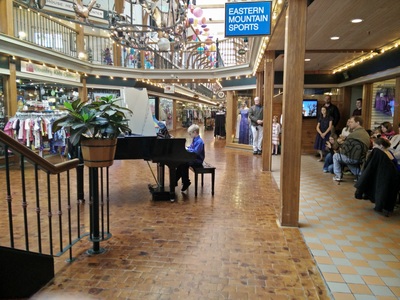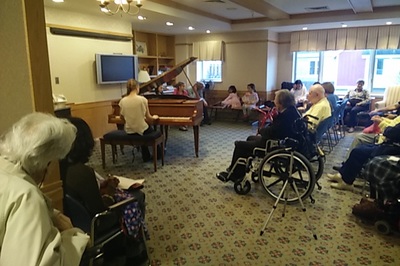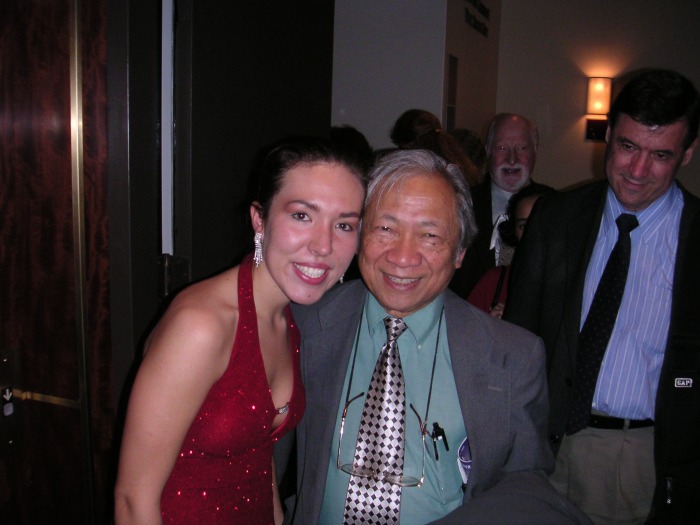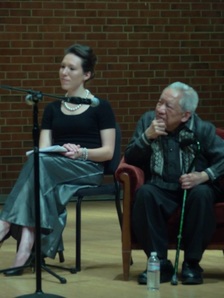 Congrats to students who performed at the Powerhouse Mall in Lebanon on Sunday! Also, thank you to Molly Bonhag for sending several of her students to join us.
0 Comments
There is so much to be said for literally moving to the music you are learning. You don't need to have training in dance. In fact - it may be better not to (as you can then feel free to do what is natural). Listen, imagine, feel, and just move. Explore the sound, the moods, and the energy. Do it a few times and develop a sense of the structure and start to tailor the movements to the phrasing.
I just started the Poulenc cello sonata this morning (the piano part!). I spent some time practicing it, and then felt a desire to explore it in a different way. My vision for the first movement quickly solidified into an exchange between two moods/characters: a spunky "petite marche militaire" and a graceful, feminine picture of elegance with a tinge of wistfulness. Now, when I go back to playing it, I have a more inspired sense of what I want it to feel like within me as well as how I want to communicate it to the audience. https://www.youtube.com/watch?v=K-f6bUVFKso Life is not about perfection. Music is not about perfection. We live and breathe for the moments of beauty that take us to another place, lift our feet off the ground, allow our hearts to soar. For every moment, there are hundreds (thousands?) of hours and days of work, effort, and keeping your chin up when the going gets tough. Here's my way to expressing this through yoga: https://www.youtube.com/watch?v=-f_aBELYnas
Congrats to Piano Prodigies students who participated in yesterday's recital. The audience loved you!
As I write this entry, I am on a Delta flight from Baltimore to Detroit, listening to a recording of a piece that's on tomorrow night's program with cellist Amit Peled. This work, "Kaddish" by Mark Kopytman, is a powerful tribute to a father and a heart wrenching interpretation of the traditional prayer that is recited by a son at his father's funeral.
Two weeks ago my most influential teacher and mentor, Professor Reynaldo Reyes, passed away at a young 82. I studied with him as a teen, continued on for my undergraduate studies at Towson University, and continued to return to him for guidance in performing and teaching (including bringing him several of my own students). But I've known him my whole life: as a member of the Baltimore Trio, my Mom was his colleague since before I was born. A couple years ago, over lunch at the Towson Diner, he told me that he had no desire to stop teaching so long he was living. "After all," he laughed, "I just keep getting better and learning more, and have more to share with my students!" In April 2015, we celebrated his decades of service to the Towson University community with a gala concert and tribute that brought together his former students from around the world. Though the event was advertised as his "retirement" celebration he continued to teach students at the university and this past January had spent several weeks touring through the Philippines. Certainly, his dedication to music and people was a powerful motivating factor in his life. Though I am still coming to grips with knowing that he no longer here, I am grateful for his incredible influence on me as a person, and as a pianist and teacher. He not only taught young pianists and inspired audiences through his performances - he touched the lives of his students with such genuine care and concern for their total development as humans that has manifested in lifelong gratitude, inspiration, and a legacy that will not be forgotten. He was among the rare breed of teachers who believe that every student is capable of learning anything. He would prove it to each student themselves by helping them learn works that surpassed their greatest expectations, and then laughing as he exclaimed, "See - it's easy!" His genuine love of teaching, exploring music, and overseeing the technical, artistic, and personal growth in his students made him a role model for all who aspire to be a teacher. His impact will live on through his students and carry on long into the future. http://www.legacy.com/obituaries/baltimoresun/obituary.aspx?pid=177783139 I gotta admit it. I'm a super-patient person and teacher, but I do have a few pet peeves. No chewing gum during lessons. Please don't play when I talk to you. And, here's one more: I cringe when I hear (advanced) piano students refer to their piano pieces as "songs."
Although we strive to imitate the phrasing of a singer, there is actually an important distinction between what we refer to as a "song" or as a "piece." This is important in casual conversation (in your lessons with your oh-so-patient teacher, when telling your friends about the repertoire you are studying or performing).. and this is crucial for publicly announcing your selection at a recital, festival, or competition. Here is my (somewhat simplified) definition: A song is written for the human voice and typically has words. A piece is a composition, typically (but not limited) written for an instrument other than voice. In other words, you sing a song, you play a piece. So... if you're learning a really awesome piano piece and want to tell someone all about it, take note of the following: Wrong: "I really love this song I'm learning." Right: "I really love this piece I'm learning." If you are announcing it in a recital: Wrong: "I'm going to play a song called Winter Rhapsody." ALMOST right: "I'm going to play a piece called Winter Rhapsody." Why almost right? Please be sure to always give the full name of the composer, the type of piece, the movement (if applicable), and any identifying numbers (note: "Op." stands for Opus and should be announced with the composition). Right: "I'm going to play Winter Rhapsody by Dennis Alexander." You may also call it a "work" or "selection." If it is a Nocturne or Sonata (or another category of piece) you can announce it as such. Wrong: "I'm going to play a song by Mozart." ALMOST right: "I'm going to play a piece by Mozart." ALMOST right: "I'm going to play a sonata by Mozart." Right: "I am going to perform a selection by Wolfgang Amadeus Mozart. This is Allegro - the first movement of his Sonata in C Major, K545. " Awesome: "I am going to perform the first movement of Wolfgang Amadeus Mozart's Sonata in C Major, K545. The tempo marking is Allegro." Got it? Good. :) Now, for a cool little example of a piece that's been turned into a song. Piano Prodigies student Morgan (age 10) was assigned a piece by Alexander Fyodorovich (FYAW-DAW-RAW-VEECH) Goedicke (GEH-DEE-KEH) that the composer himself called "A Song." I asked Morgan to write lyrics to it. She successfully did so and thus transformed the piece "A Song" into (drumroll please) a... song (that can be sung). Here's the final product. Great job, Morgan! |
AboutElizabeth Borowsky is a pianist, teacher, and composer. She is a Nationally Certified Teacher of Music in Piano (Music Teachers National Association). SubscribeCategories
All
Archives
May 2023
|
Location |
|















 RSS Feed
RSS Feed